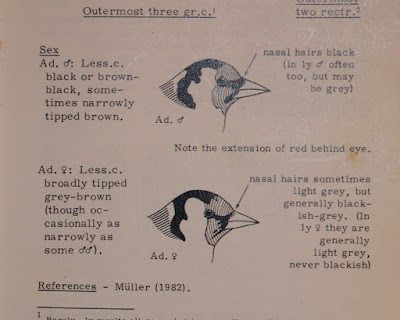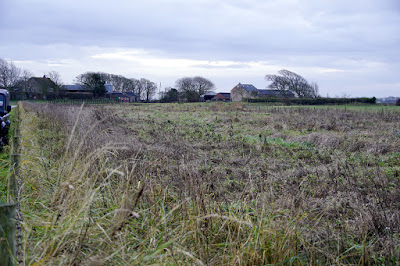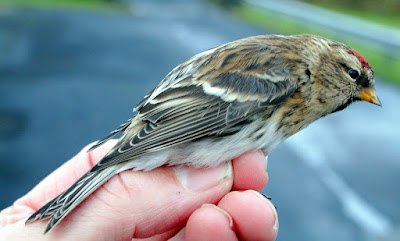I’ve not been out much this last week, mainly because of the dreadful weather. A couple of trips out proved fruitless in the way of birding, ringing or photographs. Andy and Sandra have just returned from sunny Morocco. I'm hoping they brought back sunny weather and she'll let him out to play soon.
I did manage a few sessions of garden ringing where I hoped to catch Goldfinches and perhaps the tiny male Sparrowhawk that appears intermittently and chases off the Goldfinches. Having said that, a recent kill was a Collared Dove where a large circle of feathers on the grass in the far corner of the garden proved testament to a Sparrowhawk’s deadly skill.
Sparrowhawk
Goldfinches get lots of mentions on Another Bird Blog. The reason is that our UK Goldfinch is now a very, very common bird in the countryside and in both towns and cities. It has quickly become the most common bird in gardens large & small and easily overtaken the once abundant House Sparrow. My own garden is a good example of where a glance outside on a typical day will see anything between two and twenty Goldfinches flitting between the tree tops and the eight bird feeders.
Some days the Goldfinches go missing altogether. I suspect that there is now a fairly settled winter local population which splits up each morning as birds head off in various directions on well-known and trusted routes to sources of food. I know when they are around. Their contacts calls and tinkling winter song fills the air as one by one, two by two, they fly into the tree tops and descend to the branches and feeders below.
Some individuals know my garden well. They are the ones that have a feed and then fly under or over the single mist net placed strategically east to west. And then there are the equally clever ones that fly alongside the net north or south without a right or left turn that would result in their being caught. The ones that blunder into the net may not have been here before. It’s a logical theory when taking into account how innocent fledglings of summer and autumn are more easily caught. By mid-winter even, many are yet to become familiar with the often illegitimate ways of man.
Goldfinch
Goldfinch
Goldfinch
Results from the BTO Garden BirdWatch survey show that Goldfinch numbers continue to boom in gardens. Garden bird foods and feeders have spread markedly over recent decades, enabling our UK Goldfinches to quickly exploit a niche that other birds failed to spot.
An adult Goldfinch is unmistakable with its red, white and black head, gold wing-bars and black and white wings. Although males and females look similar, the red mask of the male extends back behind the eye, whereas that of the female doesn’t. Recently fledged birds do not acquire the red face until late in the summer or during early autumn. While the features to separate male and female is accepted as the norm it is thought not quite 100% reliable.
Goldfinch - Svensson
Goldfinch
Goldfinch
Goldfinch
Bird ringers who catch and then later recapture some individuals in the breeding season will confirm that the now revealed breeding characteristics may contradict the earlier sexing of the bird according to the literature in Svensson or elsewhere.
This problem is not easily solvable since the recapture rate of Goldfinches seems quite low under normal circumstances, even less so when looking to capture adult Goldfinches during the breeding season. Many of these individuals may wander far and wide and also migrate outside of the summer months.
Goldfinches favour small, oil-rich seeds, such as nyjer and sunflower hearts that householders buy in large quantities for garden feeding stations. Agricultural intensification has resulted in reduced availability of natural weed seeds as garden feeding stations become increasingly important for birds like the Goldfinch, so much so that the Goldfinch’s success has been a major factor in the species’ population explosion.
Such seeds now appear more popular with buyers than the once ubiquitous peanut, probably because once outside the oily seeds remain attractive and do not deteriorate as quickly a peanut. Many is the time I have put out peanuts to find that after a few days of our British weather the nuts turned to a rather unpleasant mush that had to be removed for safety reasons.
With agricultural intensification resulting in reduced availability of weed seeds, garden feeding stations are increasingly important for birds like the Goldfinch.
Feeding Station
After this morning’s rain truncated effort of 7 Goldfinches ringed (and 15 or more adopting avoidance tactics), I checked my figures on the BTO's DeMon - 385 Goldfinches caught and of those, 379 new and just 6 subsequent recaptures.
Goldfinch has overtaken Linnet as my “the most encountered bird”. We really must get back to those Linnets soon.
Most Encountered Bird
Goldfinch































































.jpg)












